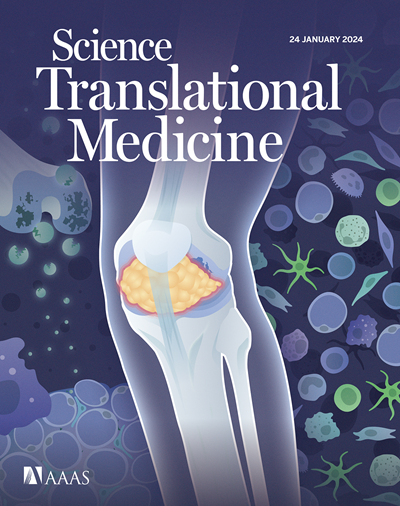二十戊二烯通过抑制环氧化酶-1诱导的血小板反应性减少动脉血栓形成
IF 15.8
1区 医学
Q1 CELL BIOLOGY
引用次数: 0
摘要
大型随机试验测试omega-3多不饱和脂肪酸(ω-3 PUFA)补充剂可减少心血管事件,但报告了相互矛盾的结果。解释这些试验是具有挑战性的,因为ω-3 PUFA的不同剂量和配方进行了测试。此外,减少心血管事件的确切机制尚不清楚。在这项研究中,我们研究了ω-3 PUFA对体外和心血管疾病患者血小板粘附、脱粒和聚集的影响。我们还研究了ω-3 PUFA在啮齿类动物动脉血栓形成模型和尾出血试验中的作用,包括环氧化酶-1 (COX-1)缺乏的动物。ω-3 PUFA二十碳五烯酸(EPA)在体外剂量依赖性地降低血小板粘附、脱粒和聚集。此外,在血栓形成前口服EPA可抑制野生型小鼠动脉血栓形成。光亲和标记和硅对接分析表明,EPA和花生四烯酸在COX-1水平上存在直接的竞争性相互作用。EPA抑制作用的COX-1依赖性被血小板特异性COX-1缺陷动物证实,这些动物没有减少EPA的血栓负担。在心血管疾病患者中,从每天2克EPA改为每天1克二十二碳六烯酸(DHA)(460毫克EPA和380毫克DHA)一次,完全减弱了EPA对血小板的抑制作用。我们的结果可以部分解释不同ω-3 PUFA配方在临床试验中的矛盾结果。本文章由计算机程序翻译,如有差异,请以英文原文为准。
Icosapent ethyl reduces arterial thrombosis by inhibition of cyclooxygenase-1–induced platelet reactivity
Large, randomized trials testing omega-3 polyunsaturated fatty acid (ω-3 PUFA) supplementation to reduce cardiovascular events have reported contradictory results. Interpretation of these trials is challenging, because different dosages and formulations of ω-3 PUFA were tested. Furthermore, the exact mechanisms for the reduction in cardiovascular events are unclear. In this study, we investigated the effects of ω-3 PUFA on platelet adhesion, degranulation, and aggregation in vitro and in patients with cardiovascular disease using different formulations of ω-3 PUFA. We also investigated the effects of ω-3 PUFA in rodent models of arterial thrombosis and in tail bleeding assays, including in cyclooxygenase-1 (COX-1)–deficient animals. The ω-3 PUFA eicosapentaenoic acid (EPA) dose-dependently reduced platelet adhesion, degranulation, and aggregation in vitro. Moreover, arterial thrombus formation in wild-type mice was inhibited by oral EPA administration before thrombus formation. Photoaffinity labeling and in silico docking analyses suggested a direct, competitive interaction of EPA and arachidonic acid at the level of COX-1. The COX-1 dependency of EPA’s inhibitory effects was confirmed by platelet-specific COX-1–deficient animals that had no reduction of thrombus burden by EPA. In patients with cardiovascular disease, switching from 2 grams of EPA twice daily to 1 gram of docosahexaenoic acid (DHA) (460 milligrams of EPA and 380 milligrams of DHA) once daily completely blunted the platelet inhibition achieved by EPA. Our results may partially explain contradictory results with different ω-3 PUFA formulations in clinical trials.
求助全文
通过发布文献求助,成功后即可免费获取论文全文。
去求助
来源期刊

Science Translational Medicine
CELL BIOLOGY-MEDICINE, RESEARCH & EXPERIMENTAL
CiteScore
26.70
自引率
1.20%
发文量
309
审稿时长
1.7 months
期刊介绍:
Science Translational Medicine is an online journal that focuses on publishing research at the intersection of science, engineering, and medicine. The goal of the journal is to promote human health by providing a platform for researchers from various disciplines to communicate their latest advancements in biomedical, translational, and clinical research.
The journal aims to address the slow translation of scientific knowledge into effective treatments and health measures. It publishes articles that fill the knowledge gaps between preclinical research and medical applications, with a focus on accelerating the translation of knowledge into new ways of preventing, diagnosing, and treating human diseases.
The scope of Science Translational Medicine includes various areas such as cardiovascular disease, immunology/vaccines, metabolism/diabetes/obesity, neuroscience/neurology/psychiatry, cancer, infectious diseases, policy, behavior, bioengineering, chemical genomics/drug discovery, imaging, applied physical sciences, medical nanotechnology, drug delivery, biomarkers, gene therapy/regenerative medicine, toxicology and pharmacokinetics, data mining, cell culture, animal and human studies, medical informatics, and other interdisciplinary approaches to medicine.
The target audience of the journal includes researchers and management in academia, government, and the biotechnology and pharmaceutical industries. It is also relevant to physician scientists, regulators, policy makers, investors, business developers, and funding agencies.
 求助内容:
求助内容: 应助结果提醒方式:
应助结果提醒方式:


